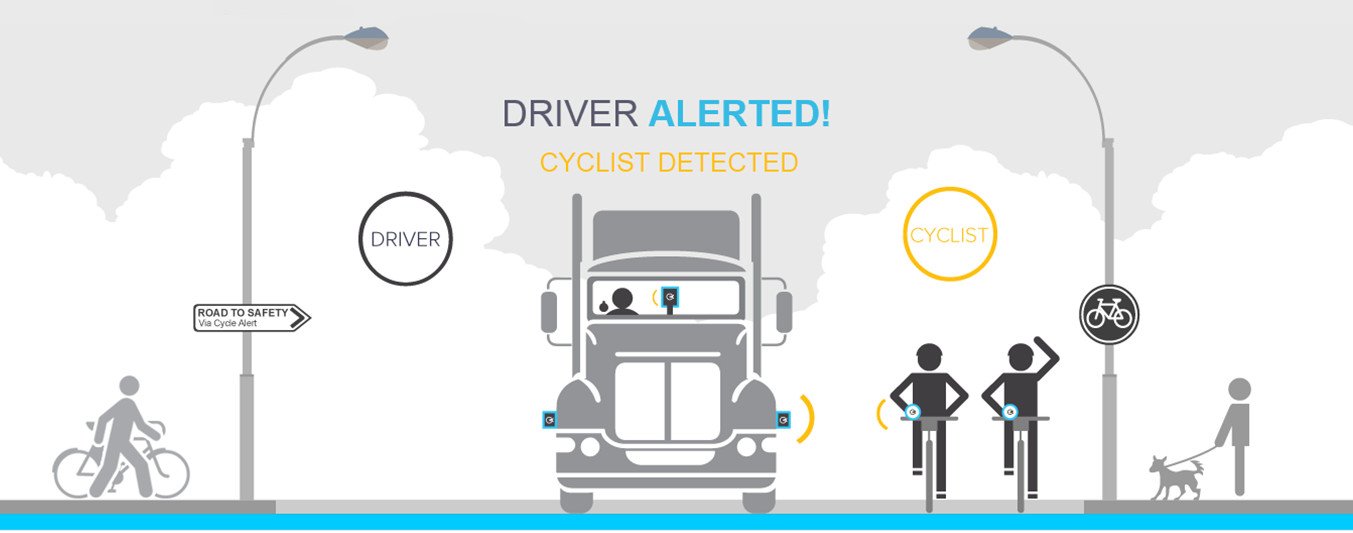 It feels as though cycling in urban areas, particularly in London, is becoming an increasingly dangerous proposition. All too often we turn on the news or look on a Facebook group to be greeted by news of another accident on our streets involving heavy goods. Awareness among cyclists is growing, with many of us avoiding dangerous junctions on our commutes, and never passing down the outside of long vehicles for example, but serious accidents are still happening on an alarming basis.
It feels as though cycling in urban areas, particularly in London, is becoming an increasingly dangerous proposition. All too often we turn on the news or look on a Facebook group to be greeted by news of another accident on our streets involving heavy goods. Awareness among cyclists is growing, with many of us avoiding dangerous junctions on our commutes, and never passing down the outside of long vehicles for example, but serious accidents are still happening on an alarming basis.
Much of London’s infrastructure was created with little or no consideration for cyclists. Roads are narrow, and many junctions are enclosed without space for vulnerable road users. As construction work has increased with the capital coming out of the recession, we are seeing more and more heavy goods and long wheel base vehicles on city roads, and the steady increase in commuting by bicycle has resulted in more opportunities for serious accidents to occur.
In 2013, 258 people were killed in collisions with HGV’s, and 1354 seriously injured, despite the HGV’s only accounting for 5% of the traffic on UK roads nationally. In London between 2008 and 2013, HGV’s were involved in 53% of cycling fatalities.
There are times when it seems as though the momentum to make changes is not there. We look at cities like Amsterdam and the provisions made for safer cycling, and we can see the impact they can make. Comparatively very low accident and serious accident rates in the Netherlands have promoted massive uptakes in cycling, and much reduced city congestion. Unfortunately, one of the major blockers to improvement may well be attitudes towards cycling as a sport itself.
A ComRes Report commissioned by the BBC in June 2014 asked a cross section of the population ‘which of the following measures, if any, do you think would reduce the numbers of road accidents and deaths among cyclists the most?’ and provided a list of possibilities. Among Londoners, where the rate of cycling deaths is the highest in the UK, the largest percentage of respondents at 34% picked ‘Compulsory lessons on road safety for cyclists who use the roads’. Just 14% believed ‘better education among truck drivers about the risks they pose to cyclists who use the roads’ would make the biggest difference, 16% better design of road junctions, and 14% more cycle-safety devices.
It seems that for many, the responsibility for safety lies not with the large vehicles sharing the roads or improvements to infrastructure, but with the cyclists themselves. To improve our cycling safety record, the first step may well be to educate the public about the dangers which exist, how they have been tackled in other cities with fantastic results, and the resulting reduction in congestion which we could stand to gain with more encouraged to cycle.
A report into reducing cycling fatalities caused by HGVs produced by Loughborough University last September worked to identify the problems that exist with current heavy vehicle design. Their findings in regards to driver’s awareness of hazards in particular were alarming to say the least.
Current EU regulation on overall vehicle length and weight have been cited for exacerbating the problem of low visibility from drivers cabs. Cyclists ahead of HGV’s at advanced stop lines, or to the left and right of these vehicles where advanced stop is not available, are often entirely obscured by the drivers cab. The Loughborough University report indicates that these ‘critical blind spots’ cannot be reliably accounted for by specially fitted mirrors due to the time delay between checking them, making observations through the windows, and pulling away from a junction.

They propose a series of solutions to improve the visibility problem, most significantly foot well level windows in both the doors and at the front of the drivers cab. While low level windows in the driver and passenger doors can be retrofitted to existing vehicles at some considerable cost, for the full impact of their recommended changes to be felt entirely new vehicles would need to be designed and produced, not to mention EU restrictions on vehicle length adapted to suit the new design.
The majority of collisions between HGVs and cyclists occur simply because the driver did not see the cyclist alongside or in front of their cab, but with the cost of replacing fleets of commercial vehicles so high, changes along these lines could take decades to come into effect.
The first of September 2015 will see the introduction of the Mayor of London’s Safer Lorry Scheme; an initiative to attempt to reduce the impact of heavy goods vehicles on cycling safety. The Mayor of London, Boris Johnson, said ‘Improving the safety of London’s roads is a top priority. We know that a large number of cyclist deaths and serious injuries involve a relatively small number of trucks and lorries that are not fitted with basic safety equipment. Such vehicles are not welcome in the capital and the Safer Lorry Scheme will see them effectively banned from our streets. The lives of thousands of cyclists and pedestrians will be much safer as a result and I urge all operators of HGVs to get on board and make it a success.’
Effectively, the scheme will ban lorries from entering into areas of London unless they conform to certain safety requirements. Namely, they must be fitted with side guards to prevent vulnerable road users from falling beneath the vehicles wheels in a collision, and certified mirrors to reduce the driver blind spots.
While a step in the right direction, The Loughborough report among others has called into question the effectiveness of these mirrors for driver awareness on busy streets, and most would agree reducing collisions between cyclists and HGVs is more important than just reducing the impact of these collisions.
A company named Cycle Alert has been trialling a new system in York, which is currently being rolled out to Central and Greater London. Cycle Alert consists of a warning system for drivers, alerting them to cyclists moving in their vicinity who may be at risk when cornering or pulling away at a junction.

They provide cyclists with tags, neat white disks which attach bikes or helmets using a simple but secure band system. The tags weigh practically nothing and won’t look at all out of place on a nice road or commuter bike, and for the most part, the cyclists is likely to forget the tag is even there. The whole time however, while riding on busy urban streets, it will be silently broadcasting the cyclists presence to nearby vehicles fitted with the Cycle Alert receiver.
Using similar technology to an Oyster Card or keyless office entry, the RFID transmitters can be produced quickly and cheaply using existing suppliers, allowing them to be distributed without any cost to the riders.
Existing vehicles can then be fitted with wireless side units, receivers for the system, which are ultrasonically welded to vehicles forming a permanent, weatherproof seal. They have an expected battery life of 10 years making their maintenance incredibly low, and send information of cyclists to a unit within the vehicle cab. When a cyclist is detected, an audible alert is sounded within the cab, alerting the driver to the hazard, with a display indicating the approximate location of the cyclist. The cab unit itself is designed to turn on with the vehicles ignition, removing the chance that a driver were to forget to, or chose not to, activate it.
A similar technology has recently been announced as a concept by Jaguar Land Rover, a system using sensors to alert drivers to nearby pedestrians and cyclists.
It is exciting to see a leading manufacturer investing in technology to improve road safety for cyclists, and raises hope that similar solutions will begin to work their way into more and more production vehicles in the future. This technology is likely to take a very long time to be embraced as a standard feature, particularly when it comes to heavy goods vehicles, the majority of which form part of business fleets.
Cycle Alert provides an opportunity to retro-fit similar technologies into existing vehicles immediately, at a huge cost saving in comparison to replacing the vehicles themselves. Entire fleets can be modified with Cycle Alert to provide a similar level of awareness to approaching cyclists, allowing early adopters of this technology to be those which require it most urgently, the commercially run heavy goods vehicles.
The Cycle Alert system has proven its effectiveness in the York trial, but its success in London will depend entirely on the pace at which it is adopted by both drivers and cyclists.
Yellow Jersey Cycle Insurance has recently announced a partnership with Cycle Alert, and as well as lending resources to marketing the system, we are also in a position to aid in tag distribution. Working in the cycling industry with a large contact list, we can begin sending tags out to customers along with our usual documentation. Beginning with London postcodes where the danger to cyclists is most acute, we can begin to build up a concentration of tags among cyclists. As Cycle Alert builds more traction within Central and Greater London, we will then look to roll the system out to the rest of the UK.
It would be amiss to suggest that a piece of technology could solve the safety issues regarding cycling in the UK. There are many problems which need to be solved with no one solution. While many of the improvements we need to make are likely to take a long time to properly implement, Cycle Alert is already being implemented in vehicles and distributed to cyclists in London, and has the potential to make a significant and immediate difference to the visibility of cyclists to Heavy Goods Vehicle drivers on our streets.